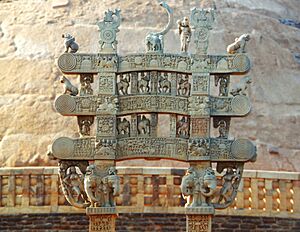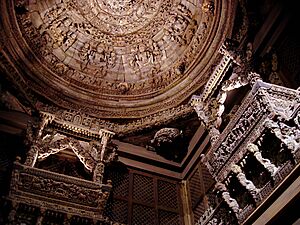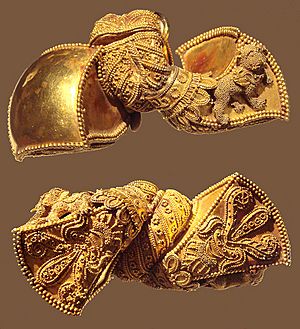Shilpa Shastras facts for kids
The Shilpa Shastras (Sanskrit: शिल्प शास्त्र śilpa śāstra) are old Hindu texts from India. Their name means "the Science of Arts and Crafts." These books contain rules and ideas for many different types of art, crafts, and designs.
For example, when building Hindu temples or making sculptures, the Shilpa Shastras acted like guidebooks. They explained how to make figures with the correct size, how to arrange them, and what they should mean.
These texts cover 64 different skills, sometimes called "external arts." These include things like carpentry, building, making jewelry, acting, dancing, music, and even poetry.
It's important to know that Shilpa Shastras are different from Vastu Shastras, though they are related. Shilpa Shastras focus on making art and crafts, such as statues, paintings, pottery, and textiles. Vastu Shastras, on the other hand, are about how to design and build structures like houses, forts, and temples.
Contents
What are Shilpa Shastras?
The word Shilpa (शिल्प) means any art or craft in ancient Indian writings, and Shastra means science. So, Shilpa Shastra means the science of art and crafts. Ancient Sanskrit texts called male artists Shilpin (शिल्पिन्) and female artists Shilpini (शिल्पिनी). The artworks themselves were called Shilpani.
Ancient Indian texts say that there are countless arts. They mention 64 different techniques (called kala) and 32 fields of knowledge (called vidyas). The Shilpa Shastras are often linked to the stories of Vishvakarma, who is seen as the divine architect and creator.
Shilpa Shastras and Painting
The Shilpa Shastras also have sections about painting, both small and large. For instance, the Narada Shilpa Shastra talks about painting in some of its chapters. The Saraswati Shilpa Shastra describes different kinds of paintings, sketches, and even how to prepare colors.
Other old Shilpa Shastras about painting include the Vishnudharmottara Purana and Chitralakshana. These texts discuss important parts of a painting, such as measurements, proportions, how the viewer sees it, hand gestures (mudra), emotions, and the overall meaning (rasa). These texts helped artists learn and share their knowledge and spiritual ideas through art.
Shilpa Shastras and Carpentry
The first part of the Shilpa Shastra Manasara explains how to measure things for carpentry. Texts from the 9th and 16th centuries describe two types of wood artists: takshaka and vardhaki. A takshaka knows about different types of wood and how to cut them. A vardhaki understands wood shapes and practices carpentry.
One of the earliest mentions of carpentry is in the ancient text Rig Veda. Carpentry was a very important art when building Hindu temples.
Shilpa Shastras and Metalwork
The Vedas, especially the Atharva Veda, talk about many arts and crafts, including metalwork. The Rig Veda mentions tools used for casting metal, like furnaces and blowers. These discussions explain how to make idols with the best proportions (talmana), stances (mudra), and expressions (bhava).
Sanskrit texts like Shilparatna and Manasara give detailed instructions for working with metals. They focus on alloys like panchadhatu (five metals: zinc, tin, copper, silver, and gold) and ashtadhatu (eight metals, adding iron, lead, and mercury to panchadhatu). The "lost wax" casting method (Madhuchista Vidhana) is often described in these old texts. Some historians believe these metalworking skills spread from India to other parts of Asia.
Even though some ancient Shilpa Shastras have been lost, we have proof of amazing metalwork from that time. For example, the 5th-century Iron Pillar of Delhi is 23 feet tall, weighs 6 tons, and is 99.72% iron. It shows almost no rust, which proves how advanced metal arts were in India back then.
Learning Shilpa Shastras in Ancient India
No Barriers to Learning
In ancient India, people from all social groups and genders could learn arts. Old texts say that anyone could practice crafts, no matter what their family's main job was. Buddhist stories mention carpenters who were Brahmins (a priestly class). Texts from the 4th century describe chariot builders, carpenters, brick-workers, potters, and metalworkers from different social groups. This shows that art was open to many.
Apprenticeship Training
Young people learned by training with experienced masters. The best students were welcomed into art guilds. Training started in childhood and included learning about dharma (right conduct), culture, reading, writing, math, geometry, colors, and tools. They also learned "trade secrets," which were passed down through generations.
Art Guilds
Artists in ancient India formed groups called śreṇi (guilds). Each guild had its own rules and ways of behaving, which even kings respected. These guilds included all artists, no matter their background. Guilds earned money from new members, fines for breaking rules, and fees on tools. They also did charity work and gave artworks to temples. During festivals, each guild would show off their skills with performances and decorated pavilions.
Art is Spiritual
In ancient Indian culture, creative work and artists were seen as very special, almost sacred. Artists believed they were expressing spiritual ideas and holiness through their art. This belief continues today in India. During an autumn festival called Dashahra, many craftspeople worship their tools with incense, flowers, and rice.
The Brhat Samhita text describes how carpenters would pray and ask for forgiveness from a tree before cutting it for wood. They would even rub the axe with honey and butter to reduce the "hurt" to the tree, as it was seen as a living being. Art was viewed as taking parts of nature and, with skill, turning them into beautiful artworks.
See also
- Artistic canons of body proportions#Classical India
- Hindu iconography
- Hindu temple
- Murti
- Talamana
- Vastu shastra
- Vishvakarma





